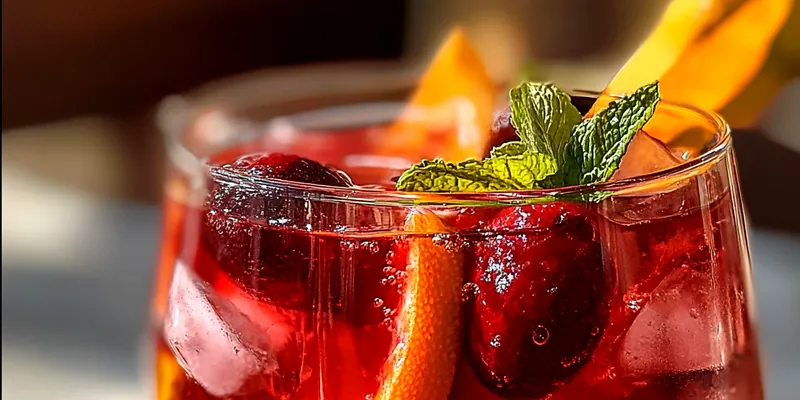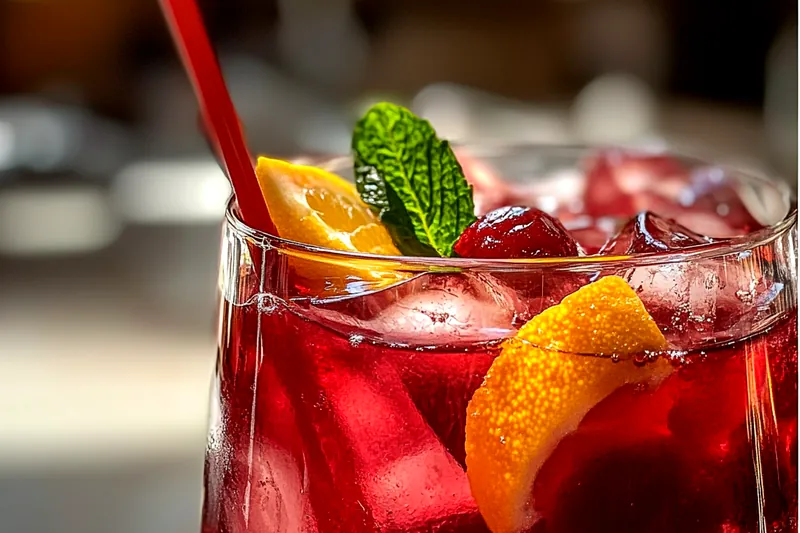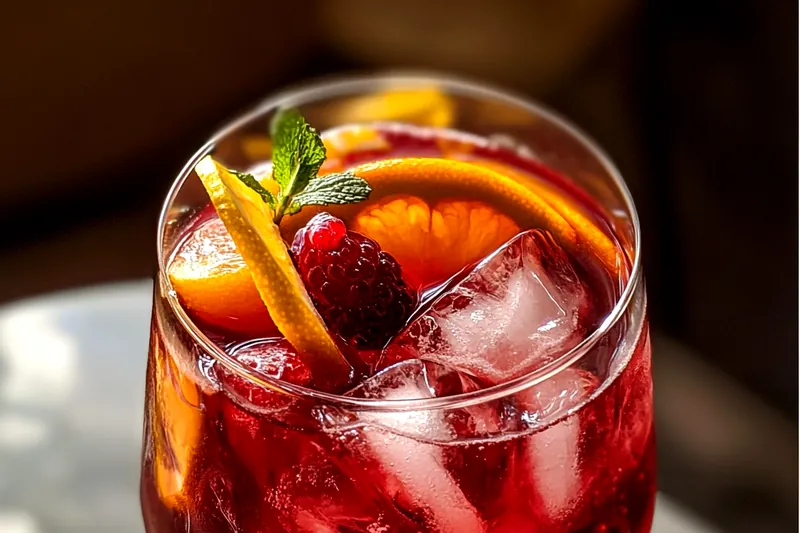Vodka Sangria Red Cocktail
This vibrant vodka sangria combines the best of traditional Spanish sangria with a modern vodka twist, creating a bold, fruity cocktail perfect for entertaining.

Building the Perfect Vodka Sangria
The secret to exceptional vodka sangria lies in balancing the robust flavors of red wine with the clean strength of vodka while allowing fresh fruit to shine. Unlike traditional sangria, the vodka adds a modern punch that appeals to contemporary palates without overwhelming the fruit.
Proper maceration time is crucial for developing complex flavors. The fruit needs time to release its natural juices and absorb the alcohol, creating a harmonious blend where each element enhances the others rather than competing for attention.
💡 Professional Tip
Muddle only half the berries to release juices while keeping some whole for texture and visual appeal. Chill all ingredients before mixing to ensure the sangria stays refreshingly cold.
Frequently Asked Questions
Minimum 2 hours for decent flavor, but 4-24 hours is ideal. The longer it sits, the more the flavors meld and the fruit infuses the wine mixture.
Use a dry, medium-bodied red wine like Garnacha, Tempranillo, or Pinot Noir. Avoid expensive wines as the other ingredients will mask subtle flavors.
Absolutely! Make it up to 24 hours ahead without the sparkling water. Add the sparkling water and ice just before serving to maintain carbonation.
A clean, premium vodka works best. Brands like Tito's, Grey Goose, or Ketel One complement the wine without adding harsh flavors.
Yes! Try cherries, pomegranate seeds, or diced apples. Stone fruits like peaches and plums work wonderfully in summer versions.
Taste before serving and add more simple syrup if needed. The fruit's natural sweetness varies, so adjust accordingly. Honey is a great natural alternative.
Replace wine with grape juice, vodka with more fruit juice, and brandy with apple juice. Use the same fruit and sparkling water for a delicious mocktail.
Refrigerate for up to 3 days. The fruit will continue to break down, making it softer but still delicious. Strain out old fruit and add fresh if desired.
Recipe Troubleshooting Guide
Too Sweet
Problem: Sangria tastes overly sweet
Solution: Add more lemon or lime juice to balance. A splash of dry wine can also cut through excessive sweetness.
Too Tart
Problem: Sangria is too acidic or harsh
Solution: Add more simple syrup or muddle additional sweet fruit like strawberries to mellow the acidity.
Weak Flavor
Problem: Sangria lacks depth and complexity
Prevention: Let it macerate longer, add more fruit, or increase the brandy slightly. Pomegranate juice adds rich color and flavor.
Too Strong
Problem: Alcohol flavor is too prominent
Recovery: Dilute with more fruit juice or sparkling water. Add more fruit to absorb some alcohol and provide balance.
Fruit Sinking
Problem: All fruit settles at bottom
Prevention: Stir gently before serving each glass. Some settling is normal and expected with traditional sangria.
Flavor Balance Issues
Too Sweet: Add fresh lemon juice or a splash of dry wine
Too Salty: This shouldn't occur, but dilute with fruit juice if needed
Bland: Increase pomegranate juice, add more fruit, or let macerate longer

Selecting Quality Sangria Components
The foundation of great vodka sangria starts with choosing the right red wine. A dry, medium-bodied wine provides the perfect canvas without overwhelming the other flavors. Spanish varietals like Garnacha or Tempranillo are traditional choices, but any dry red wine in the $10-15 range works beautifully.
Fresh, ripe fruit is essential for both flavor and visual appeal. Choose berries that are firm and fragrant, citrus that feels heavy for its size, and fruit that's in peak season for the best natural sweetness and vibrant colors.
Essential Ingredient Notes
- Red Wine Selection: Avoid overly tannic or oaked wines. The fruit and other ingredients should complement, not compete with, the wine's natural flavors.
- Berry Quality: Mix different berries for color and flavor complexity. Frozen berries work in a pinch but fresh provides better texture and appearance.
- Vodka Choice: Premium doesn't mean most expensive. Look for clean, smooth vodka that won't add harsh notes to the fruity mixture.

Mastering the Maceration Process
The key to exceptional vodka sangria is patience during the maceration process. This allows the fruit to release its natural juices and absorb the alcohol, creating a harmonious blend where no single ingredient dominates the final product.
Gentle muddling of half the berries releases immediate flavor and color while keeping some fruit intact for texture and visual appeal. The combination of crushed and whole fruit creates layers of flavor that develop over time.
The Perfect Muddle
Use a wooden spoon or muddler to gently crush berries - just enough to release juices without creating a puree. The goal is flavor extraction, not destruction of the fruit.
Vodka Sangria Red Cocktail
📋 Ingredients
For the Sangria Base
- 240ml fresh strawberries, slicedSweet berries for color and flavor
- 180ml fresh raspberriesTart berries for complexity
- 120ml fresh blackberriesRich, deep berry flavor
- 1 large orange, slicedClassic sangria citrus
- 1 lime, slicedBright citrus notes
- 360ml sparkling waterLight effervescence
- Fresh mint sprigsAromatic garnish
Fresh Fruit & Garnishes
- 750ml dry red wineMedium-bodied Spanish or French preferred
- 240ml premium vodkaClean, smooth vodka for modern twist
- 120ml pomegranate juiceAdds rich color and antioxidants
- 60ml brandyTraditional sangria spirit
- 45ml simple syrupAdjustable sweetness
- 60ml fresh lemon juiceBright acidity for balance
- 30ml fresh lime juiceAdditional citrus complexity
Instructions
Prepare Fruit
Wash and slice strawberries, cut orange and lime into rounds. Gently muddle half the berries in the bottom of a large pitcher to release juices.
Mix Base
Add red wine, vodka, pomegranate juice, brandy, simple syrup, lemon juice, and lime juice to the pitcher. Stir well to combine.
Add Fruit
Add remaining berries, orange slices, and lime rounds to the mixture. Stir gently and refrigerate for at least 2 hours or overnight for best flavor.
Serve
Fill glasses with ice and pour sangria, making sure to include fruit in each glass. Top with sparkling water just before serving.
Garnish
Garnish each glass with fresh mint sprigs and orange peel twists. Serve immediately with spoons for eating the fruit.
Recipe Notes & Tips
Make-Ahead Strategy
Prepare the sangria base up to 24 hours in advance for optimal flavor development. Add sparkling water and fresh garnishes only when ready to serve to maintain presentation.
Seasonal Variations
Adapt the fruit based on seasons - try cherries and peaches in summer, pears and apples in fall. Each variation brings unique flavors while maintaining the cocktail's character.
Party Scaling
This recipe doubles or triples easily for large gatherings. Use a large drink dispenser and provide ladles for guests to serve themselves, ensuring each glass gets plenty of fruit.
